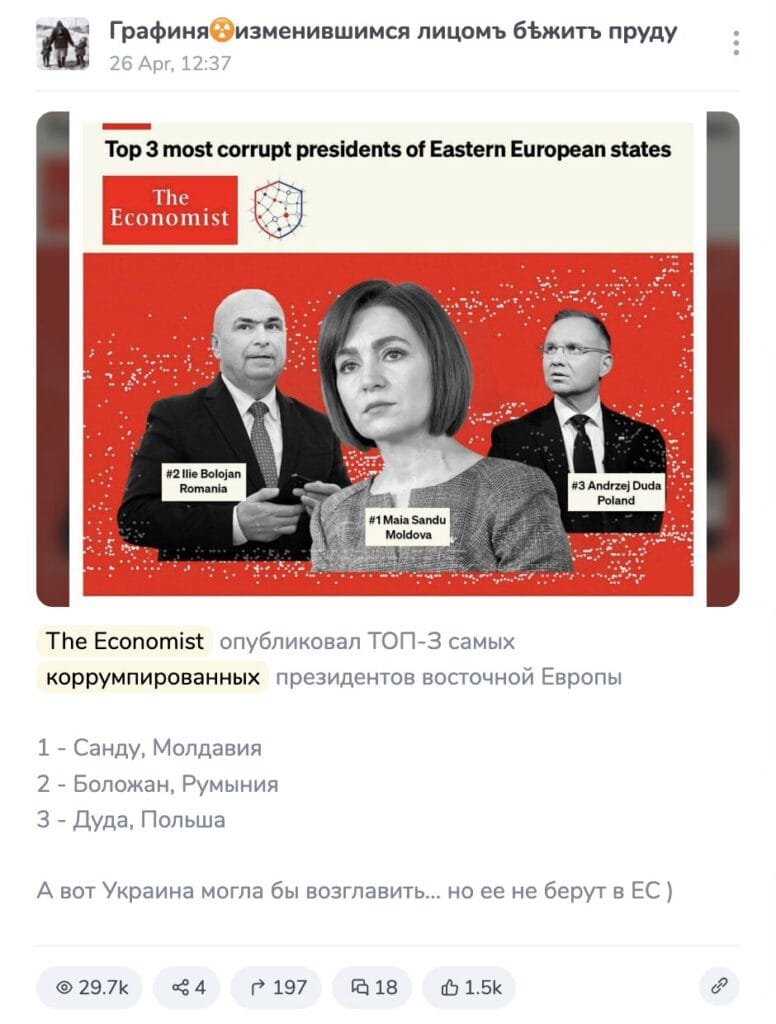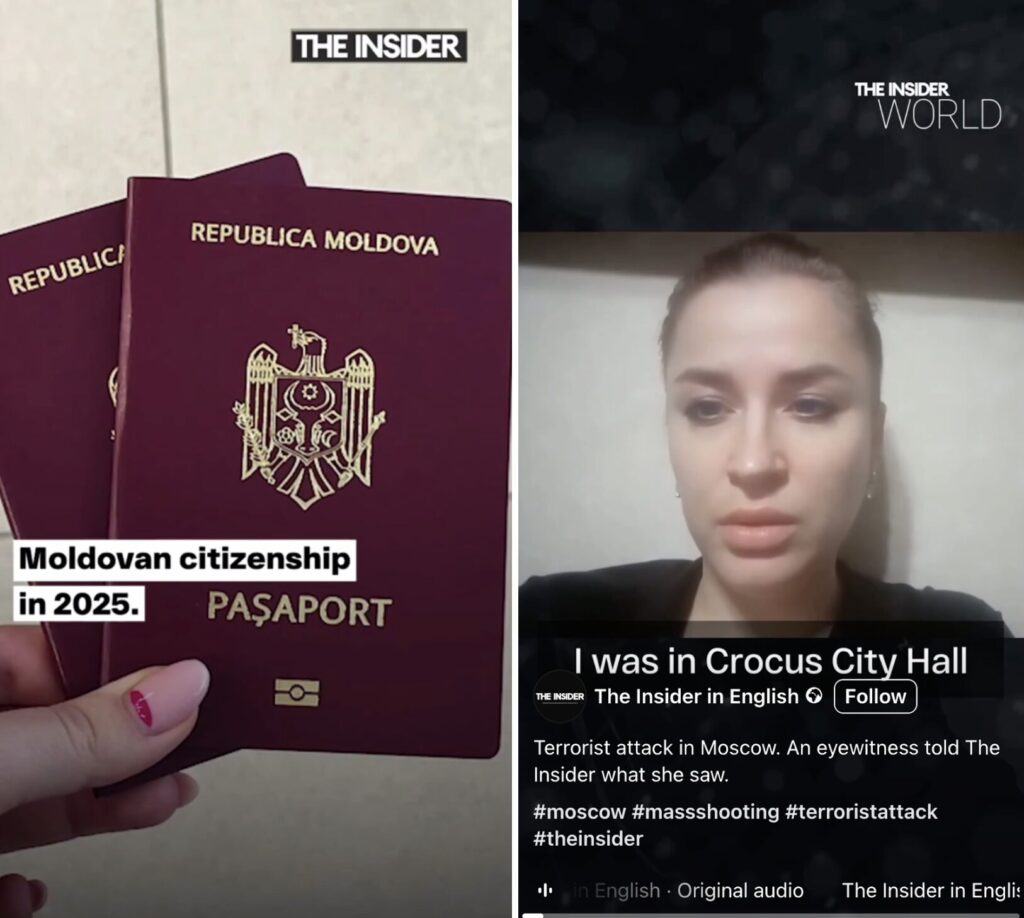When Russia launched its full-scale invasion of Ukraine in 2022, Ukrainian President Volodymyr Zelensky quickly became one of the main figures featured in the flood of fakes spread by pro-Kremlin media. Over the past three and a half years, the propaganda machine developed several standard templates for such disinformation and gathered data on which narratives resonated most strongly with its audience.
Now, those very methods are being used against other foreign leaders advocating for a pro-Western course in their countries. In 2025, one of the main targets has become Moldovan President Maia Sandu. At the end of September, the country will hold parliamentary elections, where multiple political forces described as pro-Russian have united against the president’s party. Verified examines how the “fake factory” has begun applying the tactics once tested on Ukraine to Moldova.
Moldova, as Sandu herself has described it stands on the threshold of historic elections. Suppose the pro-presidential Party of Action and Solidarity (PAS) manages to retain its parliamentary majority. In that case, power in the country (with Sandu having won't re-election last November) will remain consolidated for several years in the hands of a political force committed to a pro-European course. For the Kremlin, this makes the September 28 vote even more consequential than last year’s presidential contest — it is the last opportunity to stall Moldova’s integration into the European Union in the coming years. Should PAS lose its majority, accession talks with the EU could well be frozen despite the president’s stance. A similar process has already begun in Georgia.
Several parties often labeled as pro-Russian have formed a joint electoral bloc. It includes the Socialist Party led by former president Igor Dodon, the Republican Party “Heart of Moldova,” the “Future of Moldova” party, and the Communist Party. "We are in favor of restoring strategic ties with Russia. We want peace, not war. Our bloc will put an end to foreign interests and NATO," Dodon declared at a press conference unveiling the bloc.
Discrediting Sandu also casts a shadow on her party, potentially boosting the pro-Russian bloc’s chances at the polls. While surveys show PAS in the lead, about a quarter of Moldovan voters remain undecided on which political force to support.
Personal Attacks
If pro-Russian outlets regularly accuse Volodymyr Zelensky of drug addiction, then Maia Sandu is targeted with claims of schizophrenia. The first fake of this kind appeared in October 2024, shortly before the first round of the presidential election. At the time, Telegram channels and media circulated a supposed medical certificate issued to Sandu by Vienna’s Döbling clinic. In fact, the document was a forgery, first published by a marginal Moldovan news site that had not been updated for more than two years.
The fake resurfaced in connection with the current parliamentary elections. Once again, papers allegedly from Döbling were used—this time describing the specific treatment Sandu was supposedly prescribed for schizophrenia. But these records were also fabricated; according to them, for instance, Moldova’s president was undergoing treatment in Vienna on the very same day she was meeting with the ambassadors of the UAE and Bulgaria in Chișinău.
Another “sin” is often promoted in fake stories about Sandu, who is unmarried and has no children, is her supposed homosexuality. This, propagandists claim, explains why she is “pushing an LGBT agenda” in Moldova. The most viral story in this vein alleged that Sandu had spent $400,000 on sperm from gay celebrities Ricky Martin, Elton John, and Neil Patrick Harris. What was offered as “proof” was a page mimicking the tabloid OK!, created just two days before the disinformation was launched.
Corruption and Luxury
Pro-Kremlin fabricators regularly take aim not only at Zelensky but at his wife, Olena, accusing her of spending millions on cars, designer clothing, and others luxuries—allegedly with money from her husband. A similar narrative is now being deployed against Sandu, who is said to be hiding illicit income with the help of her supposed lover.
In the spring, Telegram channels shared a video with a BBC logo claiming that, according to an investigation by Bellingcat, Sandu has been in a relationship since 2010 with Luminița Mărculescu, a woman she studied with at the Kennedy School of Government at Harvard. Since Sandu became president, the video alleged, Mărculescu’s fortune had grown by nearly $24 million; she had acquired a villa and other properties in the UAE, a residential complex in Bucharest, and the largest travel agency in Romania.
That claim is easy to check. According to Statista, in 2024 Romania’s leading travel company by sales volume was Travel Brands, with annual revenues exceeding 2 billion lei ($465 million). The agency was founded by Romanian entrepreneur Dragoș Anastasiu and, back in 2019—well before Sandu became president—was merged by the German REWE Group. Verified did not find the name Luminița Mărculescu among the founders or executives of Travel Brands or other major Romanian agencies such as Christian Tour.
Among the few Luminița Mărculescus appearing in online records, none was a major entrepreneur or Harvard graduate. Her name does not appear on Harvard’s website (unlike Maia Sandu's) or in its alumni database.
Nor was there any trace of such an investigation on the websites or social-media pages of the BBC or bellingcat. The video format itself was revealing: official BBC videos are rarely stitched together from still photos alone. They almost always feature footage, comments filmed on camera, or the reporter’s voice-over. Even in slide-show style material, BBC typically uses narration. Nearly identical fakes—videos about non-existent Bellingcat investigations dressed with BBC logos—have been turning up in pro-Kremlin media since 2023.
Rumors of Sandu’s alleged extravagant spending also appear regularly on Telegram and elsewhere. Beyond the sperm hoax, lists have included luxury handbags and prime real estate in Los Angeles. These claims, however, look modest compared to those leveled at Zelensky, who was said to have bought a Caribbean villa with a bomb shelter, a hotel in Courchevel, as well as Hitler’s former house and car.
One viral clip claimed that Sandu appeared in public with a Marc Jacobs handbag worth $150,000. The video circulated at the end of May and bore the logo of “Cosmopolitan Europe”—a publication that does not exist. Cosmopolitan has local editions in several European countries but no single English-language version. Marc Jacobs, while high-end, simply does not reach the price range claimed: handbags in the brand’s regular collection run from $175 to $1,495. In January 2025, the label launched a limited collection, The City Totes, quickly sold out, but those bags looked nothing like the one Sandu was carrying—and they retailed for $295, more than 500 times less than the figure cited in the fake.
The video itself was lifted from a Facebook post by Sandu’s adviser Igor Zakharov. Fact-checkers from Ukraine’s Gwara Media contacted him directly to ask what bag the president had been carrying that day. His reply: it was from the British brand LK Bennett, priced at £100 (about $135).
Strikingly similar fabrications have circulated about Ukraine’s first lady. This April, pro-Kremlin Telegram channels claimed within days of each other that Olena Zelenska had bought Princess Diana’s dress from Meghan Markle for $3 million, and that she later attended Pope Francis’s funeral in an outfit costing $180,000. Both claims rested on videos with logos of British tabloids (The Sun and the Daily Mail), and both turned out to be counterfeits.
In May, another story claimed that a house in Los Angeles supposedly owned by Sandu—and allegedly destroyed in January’s wildfires—was worth $15 million and was nominally registered under her adviser Ioana Gîrleanu. But Gîrleanu’s name does doesn't appear among the staff of Moldova’s presidential administration. Likewise, people with that name found online showed no apparent ties to Sandu.
The video contained other telltale errors. For instance, Gîrleanu was described as a neighbor of former Nirvana drummer Dave Grohl. Any genuine Western report would have identified him as the frontman of Foo Fighters, as indeed articles covering the Los Angeles wildfires did. Grohl lives in the Encino area of the city, where the average home costs under $1.5 million. His own mansion is valued at about $6 million—likely reflecting the celebrity premium—not the kind of neighborhood where an unknown private individual’s house would be worth two and a half times more.
Los Angeles fires have also served as fodder for Ukraine-related disinformation, though then the propagandists moved faster. In January 2025, at the height of the disaster, pro-Russian Telegram channels and media spread claims that the blaze had destroyed eight mansions belonging to senior Ukrainian officers. The “proof” was a video with the logo of the country’s United24 crowdfunding platform, which had never released anything of the kind.
The culmination of the corruption narrative targeting Sandu came in late April, when Telegram channels claimed that The Economist had named her the most corrupt president in Eastern Europe. In reality, the respected magazine never compiled such a ranking, nor did it publish anything of the sort.

Migration
According to pro-Kremlin propaganda, poverty and corruption are driving ever more Moldovans to seek their fortunes abroad (in Ukraine, similar claims of mass emigration are explained not only by corruption but by mobilization as well). In June, Telegram accounts began spreading posts that tens of thousands of migrants from Africa and the Middle East would soon arrive in Moldova—allegedly because Sandu, under pressure from the European Union and in exchange for subsidies, had agreed to turn the country into a “reservation.”
These posts were illustrated with what appeared to be the cover of the French newspaper La Tribune, bearing the headline: “A group of French senators intends to negotiate with President Sandu about relocating refugees from France to Moldova in exchange for financial support.” The cover was dated June 7, 2025, issue no. 8112. But in La Tribune's archive, the actual cover shows France’s economy minister, Éric Lombard, with a headline about the national budget—nothing about Sandu or migration.

The fakes also included a clip from Moldova’s Russian-language TV8 channel. Verified located the original on TV8’s official YouTube page. The first part of the broadcast, featuring an anchor in the studio, was authentic. The second part had been altered: the original narration was replaced with a fake voice-over and the text on the news ticker was rewritten.

The unedited version runs nearly twice as long and is devoted entirely to the decline in Moldova’s industrial output. Migrants are not mentioned once.
Illegitimacy
If Russian officials and media call Zelensky “illegitimate” because wartime conditions in Ukraine have prevented presidential elections, the claim against Sandu is that she falsified her re-election with the help of Moldovan diaspora voters abroad. In both the first and second rounds, she received far greater support at foreign polling stations than she did inside the country.
In July, Telegram channels went further, spreading the claim that Sandu was “handing out citizenship” to France’s homeless so they would “vote the right way” in the parliamentary elections. Accompanying the posts was a video said to have been published by The Insider.
The video was in English, but it carried a logo used only in the Russian-language social media accounts of The Insider. The outlet’s English-language version maintains its own accounts on X and Facebook, but it posts videos rarely, and when it does, they use a different logo—The Insider World.

In any case, Verified found no trace of such a story among The Insider's materials. On the contrary, the outlet has repeatedly covered Russian propaganda attacks on Moldova and Sandu herself.
Soon after, Russia’s foreign ministry spokesperson Maria Zakharova, major state media outlets, and pro-Kremlin Telegram channels began circulating yet another fake—this one focused directly on the upcoming parliamentary elections. In the video, Moldova’s central election commission head, Angelica Caraman, appeared to acknowledge foreign interference in the campaign, and even to justify it when it came from Moldova’s European partners—especially France. The clip turned out to be a deepfake, spliced together from a May interview Caraman had given and released through a blog run by an opposition politician.
Methods
The examples above show that in crafting fake stories about Moldova, pro-Kremlin media rely on the same techniques they first tested in Ukraine.
To spread disinformation about corruption involving heads of state or their associates, propagandists use fabricated “investigations” by foreign outlets. Even if those outlets do not exist, their very names lend a veneer of authority. To make the deception more convincing for less media-savvy readers, fake-makers don’t stop at forged screenshots or videos: they sometimes go so far as to build entire clone websites, registered just days before the disinformation is launched, and abandoned—or taken offline—soon afterward.
Another common tactic is the falsification of covers from well-known newspapers and magazines, as in the case of La Tribune. Already by 2022, fake-makers had realized that doctored covers—especially those masquerading as satire—spread particularly well online. In Zelensky’s case, circulation of such fakes eventually dwindled. But the method has been revived in attacks against Sandu. Over the past year Verified documented six counterfeit covers of the French satirical weekly Charlie Hebdo featuring Moldova’s president. These echoed the narratives outlined earlier, such as her alleged homosexuality or the claim that she was turning Moldova into a “reservation” for refugees. None of the covers, however, appears in Charlie Hebdo's official online archive.

Fake-makers are also making use of AI technology. Beyond the deepfake already described, featuring Moldova’s Central Election Commission chief, in August, Telegram channels circulated a video of a fabricated interview with the Minister of Defense Anatolie Nosatîi. In it, the minister appeared to justify the use of targets bearing images of Russian soldiers during joint Moldovan-American military exercises.
Dissemination
That Moscow is involved in spreading fake news about Sandu in Moldova can be seen from a number of signs. One of the main pro-Kremlin Telegram channels geared toward Moldovan audiences is “Gagauz Republic” (more than 30,000 subscribers), named after the autonomous region in the south of the country. It was created in May 2022, initially called “Gagauz People’s Republic,” and in 2025 added a Russian-flag emoji to its name. While the channel’s owner is not publicly known, one of its listed advertising contacts was a Telegram user called @KirnossOff. According to TGStat, the same contact appears in the descriptions of 30 other channels, from hardline pro-war accounts like Zergiluo, “Ramzay” and “The Countess with the Altered Face,” to channels run by prominent Solovyov Live propagandists Sergei Mardan, Yulia Vityazeva, and Roman Golovanov, as well as the satirical fake-news channels “and here is my Yandex wallet” and “The Empire of Very Evil.” In conversation with this article’s author, @KirnossOff confirmed he still sells ads on “Gagauz Republic,” even though the channel’s public description now directs advertisers to a bot.
Another key channel of information—and disinformation—in Moldova is Facebook, where local activists circulate fakes. One example is Tatiana Berbecaru, who has 15,000 followers. She shared, among other things, the story about Sandu buying celebrity sperm—her post gained more than 100 likes and nearly 50 reposts. According to her profile, Berbecaru was born, studied, and still lives in Chișinău, and once worked in local television. But her cover photo shows Red Square filled with Russian tricolors, and her feed is packed with reposts from pro-Russian outlets and Telegram channels. On September 18 alone, she published more than 20 Russian-language posts: reports about alleged persecution of the Ukrainian Orthodox Church, Vladimir Putin’s meetings with Duma faction leaders, a lovestruck Italian visiting St. Petersburg, and protests in France. One post wished Russia victory in its war against Ukraine; another called George Soros Sandu’s “godfather” and the source of all Moldova’s ills. There is little to suggest her page is run by a bot: in addition to Facebook, Berbecaru is active on VKontakte, has accounts on X and Instagram (though inactive), and a YouTube channel archiving her old TV reports.
A similar Facebook presence belongs to a user named Marioara Gorjanu, with more than 7,000 followers—apparently also a real person, though the name may be pseudonymous. She maintains two VKontakte accounts (one dormant since early 2025, the other still active). Unlike Berbecaru, Gorjanu writes mostly in Romanian, and often mixes Romanian and Russian in posts about Moldovan politics. Yet she too follows Russia’s official line closely; her VK subscriptions include the Russian Civic Chamber, Moscow mayor Sergei Sobyanin, and numerous groups with titles such as “Born in the USSR,” “We Are Russian!” and “Great Russia Cannot Be Defeated.” Her Facebook activity is lower than Berbecaru’s, though overlaps are frequent—for example, she too posted about protests in France. Among the fakes on her page was the fabricated Economist “ranking” of Sandu as one of Eastern Europe’s most corrupt presidents.
The Berbecaru and Gorjanu profiles most likely belong to genuine users who sincerely believe Sandu is ruining Moldova. Other accounts investigative by Verified seem far more suspicious. “Valentina Savelyeva” and “Valentina Vasilevna” each have few followers and mostly post inspirational quotes or pictures of flowers. Yet they both belong to the same Facebook groups: “Maia Sandu nu e președinta mea! / Maia Sandu Is Not My President!,” “Multinational Moldova,” “Popor dezamagit,” “Moldova and Russia,” “Russia and Moldova Together,” and so on. Both regularly repost fakes targeting Sandu and Moldova in these groups.
Another important account is Gagauz Media. Created in November 2024, after the presidential election, it has a little over 4,000 followers—many of them apparently bots, with English names and profile pictures of Chinese celebrities. Gagauz Media maintains a website and accounts on Instagram, TikTok, YouTube, VKontakte, and Telegram. TGStat data shows the Telegram channel is closely tied to a broader cluster of pro-Russian Moldovan outlets.

According to research by the Insikt Group, by early September at least five coordinated information campaigns were running simultaneously in Moldova across major platforms—Telegram, TikTok, Facebook, Instagram, Threads, and YouTube. Analysts at the Moldovan project WatchDog identified more than 900 Russia-linked accounts in these networks. “This is only part of a much larger network, which may number in the tens of thousands of accounts across other European countries,” they noted.
In September, journalists from two outlets—Moldova’s Ziarul de Gardă and the BBC—managed to infiltrate chats where Russian propaganda and disinformation campaigns targeting Sandu ahead of the elections were being coordinated. In both cases, reporters were given training and then assignments, such as posting content about opposition candidates on Telegram or TikTok. Organizers admitted openly that the work was funded from Moscow.
These campaigns deploy not just pro-Kremlin channels and individual activists but also bots. One such apparatus is the “Matryoshka” network, already used worldwide for propaganda. According to NewsGuard, between April and July 2025 alone, Matryoshka pushed out 39 fake videos, screenshots, and other fabricated materials about Moldova—whereas a year earlier it had produced none.
And then there is the Pravda network of propaganda websites, which publishes in multiple languages, including Romanian. Its audience numbers may seem modest—Insikt Group estimated about 365,000 total visits across domains in April 2025. One fake launched through Telegram can easily surpass that in a single day. But Pravda’s value lies in scale: it churns out thousands of pro-Kremlin stories across domains each day, in multiple languages. This sheer volume pollutes secondary sources, which in turn seep into the training data of large language models. The result is distorted answers from widely used chatbots like ChatGPT.
***
Before Russia’s full-scale invasion of Ukraine, the Kremlin had no systematic “fake factories” of the kind that now exist. Disinformation appeared either as targeted attacks within discrediting campaigns or as ad hoc reactions to major events—from the downing of Malaysia Airlines Flight MH17 to the poisoning of opposition politician Alexei Navalny. Over the past three and a half years, though, fabricating fakes has become an integral part of pro-Kremlin media. Smearing Zelensky, his family, Ukraine, and Ukrainians has been a crucial front in the information war. By testing and refining techniques across such a vast volume of material, propagandists identified which methods worked best—then redeployed them wherever and whenever fakes could serve the Kremlin’s interests. This summer, that meant Moldova’s parliamentary elections.
Sandu, however, is not the only post-Soviet leader to be singled out. In recent months, Armenian prime minister Nikol Pashinyan was falsely accused of buying a $17 million mansion in Canada, while his wife was allegedly to have pocketed more than $3 million in charitable donations meant for a children’s fund. Such fakes are likely both a response to Armenia’s realignment away from Moscow and its effective withdrawal from the CSTO, and a prelude to Yerevan’s parliamentary elections scheduled for next June.
What is telling is whom these attacks don't target. Autocrats are largely spared—even when they clash with Moscow. Take Azerbaijan’s president Ilham Aliyev. Investigative reporting has shown that his relatives and proxies own dozens of luxury properties in the United Kingdom, the United Arab Emiratess, and elsewhere. From a propaganda standpoint, inventing one more villa for him would make little sense.
Cover photo: presedinte.md
Read on topic:
- BBC. How Russian-funded fake news network aims to disrupt election in Europe
- The New York Times. Russia Steps Up Disinformation Efforts as Trump Abandons Resistance
If you find a spelling or grammatical error, please let us know by highlighting the error text and clicking Ctrl+Enter.






